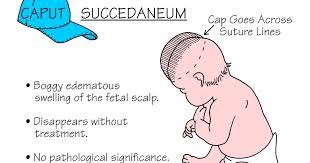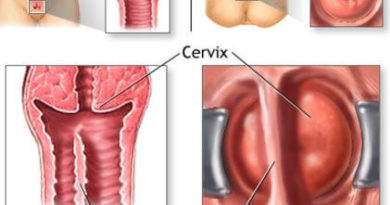Caput Succedaneum
What is Caput Succedaneum?
Caput succedaneum is a condition where the infant’s scalp is swollen and appears like a bump or lump immediately after delivery 2, 3. It is due to the pressure exerted on the infant’s head by the vaginal wall during delivery.
This condition does not indicate injury to the brain and cranium bones of the infant and is harmless. But sometimes it can cause jaundice on the infant’s skin and eyes.
Jaundice is where the skin and eyes of the infant become yellowish due to excess bilirubin in the blood. Caput succedaneum should not be confused with cephalohematoma, although all of them occur during delivery.
Cephalohematoma is a condition that causes bleeding under the infant’s scalp.

Causes
Caput succedaneum is caused by the following:
Prolonged pressure
During delivery, the infant can delay to come out. This allows the vaginal wall and expanded cervix of the mother to exert pressure on the infant’s head.
Normally, the infant’s skull has smaller pieces of bones that eventually combine to become one. Therefore, when vaginal wall or expanded cervix exerts force on the infant’s skull, these bones are forced to overlap at the sutures leading to an unusual head of the infant (the head appear pointed). Sutures refer to the point where small bones of the skull meet.
Rapture of amniotic sac membrane
Amniotic sac is found inside the uterus of a woman (woman’s womb) and contains fluids. This is the place where the unborn child grows and develops. The amniotic fluid helps the unborn baby to float and move easily in the uterus. It therefore protects the unborn baby against any injury while moving and floating in the uterus.
Normally, the amniotic fluid breaks before and during labor and drains out via your vagina. In case your amniotic fluid breaks before you start labor, you will not be able to control the fluid.
If you delay to see the midwife unit or hospital, you will lose a lot of amniotic fluid. This exposes your unborn child to infections because little amniotic fluid cannot protect the unborn against infections and injury.
Risk Factors
There are some factors that can increase the chances of your unborn baby to develop caput succedaneum. They include:
Vacuum extraction is a procedure conducted through the vagina to help deliver the baby. In this procedure, your health provider uses the vacuum, which has a cup, handle and vacuum pump and applies it on the baby’s head to help the baby out of the vagina.
The procedure can be recommended during the second phase of labor when you are pushing or when the baby’s survival depends on immediate delivery. Vacuum extraction procedure can lead to damage on the baby’s skull because the vacuum is applied on the baby’s head causing caput succedaneum.
Smaller pelvic area
Pelvic area varies among women. Those who have a smaller pelvic make it difficult for the baby’s head to move comfortably through the birth canal. This delays the delivery and as a result more pressure from the pelvic wall is exerted on the baby’s head causing injury.
Size of baby
The size of the baby is critical in delivery. The smaller the size of the baby, the faster the delivery because the baby moves with easy through the birth canal.
However, when the baby is large, he or she occupies bigger space in the birth canal leading to increased pressure from the vaginal wall on the head and body of the unborn child. This can damage the baby’s head leading to caput succedaneum.
There are some delivery decisions that your doctor can make depending on your condition. The doctor can recommend normal delivery or a C-section. If your doctor takes a lot of time to make a delivery decision or delivers the baby incorrectly, excessive pressure can be applied to the head of the baby causing damage that can lead to caput succedaneum.

Symptoms
Newborn babies usually will have noticeable swelling on their scalp, which is tender and puffy. A baby with caput succedaneum may have a different color on their swollen scalp area or even a possible mark or bruising. Sometimes, the swelling on the baby’s head can affect both sides of the scalp.
Some babies may have a swollen or bruised face if the baby’s face was the first to come out during delivery. Also, other babies may have a pointed head, which is usually called molding.
Diagnosis
Prenatal ultrasound
This can be used to detect caput succedaneum. Prenatal ultrasound is a medical procedure that uses high frequency sound waves produced by the transducer to check the abdomen. It produces echoes and photographic pictures of inside of your abdomen. The procedure is used during pregnancy to produce the baby’s images, the ovaries, placenta, amniotic sac.
It can also detect abnormalities in your uterus. Most of prenatal ultrasound are conducted on your skin in the presence of a gel to improve the quality of the images produced.
Transvaginal ultrasound
Another procedure called transvaginal ultrasound can be used to produce clearer pictures of your abdomen and detect abnormalities. This procedure uses a tabular tube, which is inserted into your vagina.
With prenatal ultrasound, it is conducted on pregnant women around the 20 weeks of pregnancy.
Treatment
Usually caput succedaneum has no treatment; the swelling disappears on its own. However, Jaundice which is the main complication of caput succedaneum should be treated early enough to avoid further complications that can cause infant’s brain damage. Jaundice in newborn can be treated by using the following:
Intravenous immunoglobulin
Immunoglobulin is a blood protein that is injected through the veins. It is used to reduce the antibodies levels in the baby and lessen jaundice.
Phototherapy
The newborn baby is put under a special lighting that releases light. This light alters bilirubin molecules’ structure so that it is removed through stool and urine.
Complications
One of the complications newborn babies can have as a result of caput succedaneum is jaundice. Jaundice occurs when there is too much bilirubin in the baby’s blood. It causes the skin and eyes of the newborn to become yellow. Caput succedaneum can cause bruising of the newborn skin, which can result in Jaundice.
Reference List
- Caput succedaneum. Available at http://heydoctor.org/caput-succedaneum.html
- Swollen Scalp (Caput Succedaneum and Cephalohematoma). Available at http://www.impcna.com/intranet/Nelson%20Pediatric/Newborn/SwollenScalp%5B1%5D.pdf
- Caput succedaneum. Available at https://www.scripps.org/articles/2563-caput-succedaneum
- Caput Succedaneum (Swelling of the Scalp during Labor). Available at http://www.healthline.com/health/caput-succedaneum#overview1











